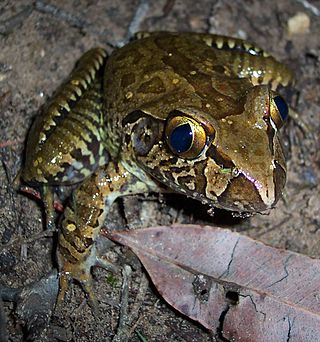
Conondale National Park is 130 km north of Brisbane in the Sunshine Coast Hinterland near the town of Conondale in the south east Queensland bioregion. The park covers an area of 35,648 hectares protecting large areas of subtropical rainforest, woodlands, wet and dry sclerophyll forest including Queensland's tallest tree. The park contains areas of regenerating forest which have been previously logged; areas of forest plantations also border the park. The park is currently managed by the Queensland Government under the Nature Conservation Act 1992.

Kōwhai are small woody legume trees within the genus Sophora in the family Fabaceae that are native to New Zealand. There are eight species, with Sophora microphylla and S. tetraptera being the most recognised as large trees. Their natural habitat is beside streams and on the edges of forest, in lowland or mountain open areas. Kōwhai trees grow throughout the country and are a common feature in New Zealand gardens. Outside of New Zealand, kōwhai tend to be restricted to mild temperate maritime climates.
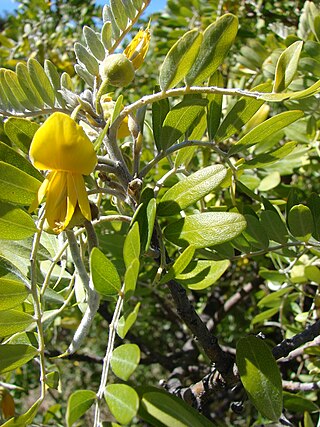
Sophora is a genus of about 45 species of small trees and shrubs in the pea family Fabaceae. The species have a pantropical distribution. The generic name is derived from sophera, an Arabic name for a pea-flowered tree.

Sophora toromiro, commonly known as toromiro, is a species of flowering tree in the legume family, Fabaceae, that is endemic to Easter Island.
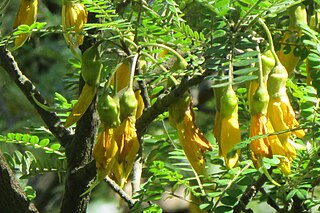
Sophora fernandeziana is a species of flowering plant in the family Fabaceae, that is endemic to the Juan Fernández Islands of Chile. It is threatened by habitat loss.
Sophora mangarevaensis is a species of flowering plant in the family Fabaceae, that is endemic to French Polynesia.
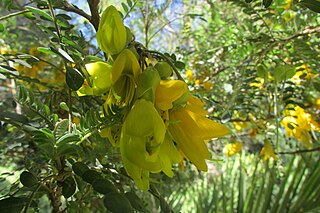
Sophora masafuerana is a species of flowering plant in the family Fabaceae, that is endemic to the Juan Fernández Islands of Chile. It is threatened by habitat loss.
Sophora rapaensis is a species of flowering plant in the family Fabaceae, that is endemic to French Polynesia.
Sophora saxicola is a species of flowering plant in the family Fabaceae, that is endemic to Jamaica.
Sophora wightii is a species of flowering plant in the family Fabaceae, that is endemic to Tamil Nadu, India.

The Hawaiʻi ʻamakihi, also known as the common ʻamakihi, is a species of Hawaiian honeycreeper.

Hibiscadelphus hualalaiensis is a species of flowering plant in the mallow family, Malvaceae, that is endemic to the Big Island of Hawaii. The last known plant died in 1992, making it most likely extinct in the wild; any remaining plants are threatened by habitat loss. It inhabits dry and mixed mesic forests on the slopes of Hualālai at elevations of 915–1,020 m (3,002–3,346 ft). Associated plants include ʻōhiʻa lehua, lama, māmane, naio, ʻālaʻa, pāpala, ʻaiea, poʻolā, and Kikuyu Grass. H. hualalaiensis is a small tree, reaching a height of 5–7 m (16–23 ft) and trunk diameter of 30 cm (12 in).
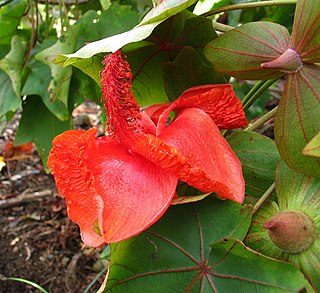
Kokia drynarioides, commonly known as Hawaiian tree cotton, is a species of flowering plant in the mallow family, Malvaceae, that is endemic to the Big Island of Hawaii. It inhabits dry forests at elevations of 455–1,915 m (1,493–6,283 ft). Associated plants include ʻāheahea, ʻaʻaliʻi, hala pepe, wiliwili, uhiuhi, kōlea, ʻaiea, kuluʻī, ʻālaʻa, ʻohe kukuluāeʻo, māmane, and maua. It is threatened by habitat loss and competition with invasive species, such as fountain grass.
Dracaena konaensis, synonym Pleomele hawaiiensis, the Hawaiʻi hala pepe, is a rare species of flowering plant that is endemic to the island of Hawaiʻi in the state of Hawaii.

The great Maui rail or great Maui crake is an extinct bird species from Maui, one of two flightless rails which survived on Maui until people arrived in 150 C.E.

Styphnolobium japonicum, the Japanese pagoda tree is a species of tree in the subfamily Faboideae of the pea family Fabaceae.

Sophora tetraptera, commonly known as large-leaved kōwhai, grows naturally only in the central east of the North Island in New Zealand. S. tetraptera has larger more widely spaced leaves than the other seven species of kōwhai.

Sophora tomentosa, also known as necklacepod, yellow necklacepod, and occasionally as silver bush, is a pantropical shrub or small tree in the family Fabaceae. It commonly ranges in height from 4 to 10 feet and often occurs in coastal conditions and near wetlands. The common name Necklacepod is derived from the characteristic string of seed pods that develop after its yellow flowers germinate into seeds.
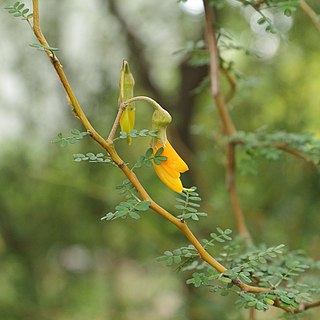
Sophora prostrata is commonly known as kōwhai, prostrate kōwhai or dwarf kōwhai and is endemic to the eastern South Island from Marlborough to the Waitaki Valley in New Zealand although most commonly found on the Banks Peninsula.













